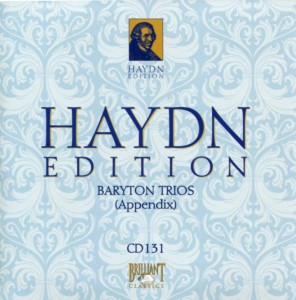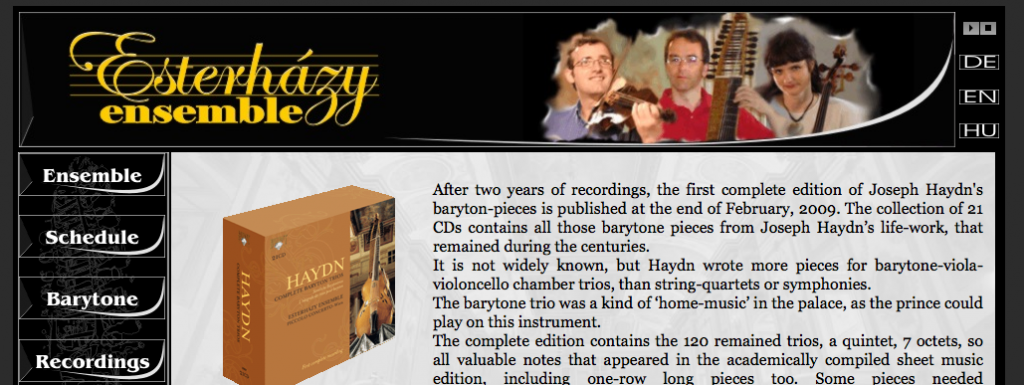 The title of today’s CD (Haydn CD 131) is “Baryton Trios (Appendix).”
The title of today’s CD (Haydn CD 131) is “Baryton Trios (Appendix).”
At the outset, I have no idea why.
But I’ll tell you this: the music makes me feel sophisticated and smart. It has a sweet, almost melancholy feel to it.
And something more than that, as I’ll mention shortly.
As I listen to this CD, I see that it’s a collection of very short passages of music, the very definition of “snippet.”
One track (#13) is only nine seconds long.
Yes, I wrote nine seconds.
This hodgepodge of short works that have survived down through the centuries are like appendices in books – supplemental material at the end. Hence the name of today’s CD.
Listening to these selections is a haunting experience.
I feel like I’m peeking inside Haydn’s head, hearing little bursts of his thoughts, stray notes like birds on a wire, random, purposeless. Mere ideas, quite unfinished – like a conversation that begins and trails off.
Tracks 30-42, especially, are absolutely engrossing. The echo/reverb on the instrument playing each piece – which ends a few seconds after it begins – gives these tiny passages of music a dream-like quality.
This was a singular experience. I dub this CD FAVORITE!
Three of the performers on today’s CD are the same as they have been all along for the baryton trios:
 They comprise the Esterhazy Ensemble and are:
They comprise the Esterhazy Ensemble and are:
Michael Brussing baryton
Andras Bolyki viola
Maria Andrasfalvy-Brussing cello
If you’d like to know what these performers look like when they’re playing, here you go:
NOTE: The baryton instrument is in the middle.
In addition to those three performers, today’s CD adds these five:
Jenping Chen violin
Johanna Hamerith violin
Roberto Sensi violone
Gabriel Rocchetti horns
Fabio Fontana horns
That makes eight musicians, an octet.
The horns, especially, are a welcome addition. I love horns and consider little more soothing than the sound of a French horn.
By the way, a violone is about what you’d think given its name: a member of the violin or viola family. Here’s what the article on Wiki says about the violone:
The violone is sometimes a fretted instrument, and may have six, five, four, or even only three strings. The violone is also not always a contrabass instrument. In modern parlance, one usually tries to clarify the ‘type’ of violone by adding a qualifier based on the tuning (such as “G violone” or “D violone”) or on geography (such as “Viennese violone”), or by using other terms that have a more precise connotation (such as “bass violin” or “violoncello” or “bass viol”). The term violone may be used correctly to describe many different instruments, yet distinguishing among these types can be difficult, especially for those not familiar with the historical instruments of the viol and violin families and their respective variations in tuning.
Some of the selections on today’s CD are called Divertimenti, which is what I’ve been listening to lately in the Octet CDs.
The word “Divertimento” is just about what it sounds like. According to the article on Wiki,
Divertimento (/dɨˌvɜrtɨˈmɛntoʊ/; from the Italian divertire “to amuse”) is a musical genre, with most of its examples from the 18th century. The mood of the divertimento is most often lighthearted (as a result of being played at social functions) and it is generally composed for a small ensemble.
Divertimento is used to describe a wide variety of secular instrumental works for soloist or chamber ensemble. It is a kind of music entertainment although it could also be applied to serious genres. After 1780, the term generally designated works that were informal or light.
As a separate genre, it appears to have no specific form, although most of the divertimenti of the second half of the 18th century go either back to a dance suite approach (derived from the ‘ballet’ type of theatrical divertimento), or take the form of other chamber music genres of their century (as a continuation of the merely instrumental theatrical divertimento).
I’m not sure it’s possible to accurately date these tiny pieces of music. So I’m not going to worry about pinning down their dates of composition. Doesn’t really matter.
Nor am I going to list all of these pieces of music. There are 42 tracks on this CD. To list all of these would take an hour.
That’s what they call a fool’s errand.
What’s important is that this music is very intimate, wholly unlike anything else I’ve yet heard.
I wholeheartedly recommend this CD.
